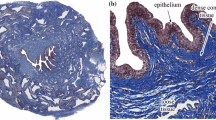Abstract
Models of the female urethra have been constructed, each consisting of a distensible tube with a pressure maximum or elastic constriction near its midpoint. By measuring by two different methods the relation between the fluid pressure and the cross-sectional area at the elastic constriction, we have tested the assumption, important in the understanding of flow through such tubes, that the pressure in the tube depends only on the local cross-sectional area. The assumption is valid for elastic constrictions characterised by a broad pressure maximum, but becomes increasingly incorrect as the pressure maximum is progressively more sharply localised. Clinical data suggest that it may not be correct for the resting female urethra.
In addition, the indirect Brown-Wickham method of measuring intra-urethral pressure, often used clinically, is found to be accurate within ±2 cm H2O in the model urethra.
Sommaire
On a construit des modèles de l'urètre femelle, dont chacun comporte un tube dilatable avec une pression maximum ou une constriction élastique près de son milieu. En mesurant, par deux méthodes différentes, la relation entre la pression exercée par le fluide et la section transversale au niveau de la constriction élastique, nous avons mis à l'épreuve l'hypothèse, importante pour la compréhension du débit par ces tubes, que la pression dans le tube dépend uniquement de la section transversale localisée. L'hypothèse est valable pour des constrictions élastiques caractérisées par une plage de pression maximum assez large, mais devient de plus en plus erronée au fur et à mesure que la pression maximum se localise. Selon certaines données cliniques, il est possible que cette hypothèse ne soit pas correcte pour l'urètre femelle au repos.
De plus, la méthode indirecte Brown-Wickham de mesurer la pression intra-urétrale, utilisée souvent à des fins cliniques, s'avère exacte à ±2 cm H2O dans le modèle d'urètre.
Zusammenfassung
Es wurden Modelle der weiblichen Harnröhre hergestellt, die jeweils aus einer ausweitbaren Röhre mit einem Druckmaximum oder einer elastischen Verengung in der Nähe des Mittelpunktes bestanden. Durch Messen des Verhältnisses zwischen Flüssigkeitsdruck und Querschnittsbereich an der elastischen Verengung mit Hilfe zwei verschiedener Verfahren haben wir die Annahme geprüft, daß der Druck in der Röhre lediglich com örtlichen Querschnittsbereich abhängt. Diese Annahme ist zum Verständnis des Durchflusses durch solche Röhren wichtig. Die Annahme gilt für elastische Verengungen, die sich durch ein berites Druckmaximum charakterisieren, wird jedoch im wachsenden Maße ungültig, wenn das Druckmaximum progressiv schärfer lokalisiert wird. Die klinischen Daten lassen darauf schließen, daß sie für die ruhende weiblichen Harnröhre nicht zutreffen.
Ferner wurde festgestellt, daß das indirekte Brown-Wickham-Verfahren zum Messen des Drucks in der Harnröhre, das häufig klinisch verwendet wird, bei der Modellharnröhre eine Ungenauigkeit von ±2 cm H2O aufweist.
Similar content being viewed by others
References
Brown, M. (1975)In vivo determination of error in the measurement of urethral pressure by the method of Brown and Wickham.Brit. J. Urol. 47, 445–448.
Brown, M., andWickham, J. E. A. (1969). The urethra pressure profile.ibid. 41, 211–217.
Edwards, L., andMalvern, J. (1974) The urethral pressure profile: Theoretical considerations and clinical applications.Brit. J. Urol. 46, 325–336.
Griffiths, D. J. (1971) Hydrodynamics of male micturition—I. Theory of steady flow through elastic-walled tubes.Med. & Biol. Engng. 9, 581–588.
Griffiths, D. J. (1973). The mechanics of the urethra and of micturition.Brit. J. Urol. 45, 497–507.
Griffiths, D. J. (1975b) Negative-resistance effects in flow through collapsible tubes: Part 2. Two-dimensional theory of flow near an elastic constriction.Med. & Biol. Engng. 13, 791–796.
Plevnik, S. (1974) Model of the proximal urethrameasurement of urethral stress profile. Proceedings of the 4th Annual Meeting, International Continence Society, 1974. Urologia Internationalis, to be published.
Author information
Authors and Affiliations
Rights and permissions
About this article
Cite this article
Martin, S., Griffiths, D.J. Model of the female urethra: Part 1—Static measurements of pressure and distensibility. Med. & biol. Engng. 14, 512–518 (1976). https://doi.org/10.1007/BF02478048
Received:
Accepted:
Issue Date:
DOI: https://doi.org/10.1007/BF02478048




